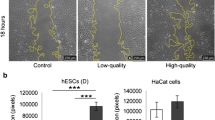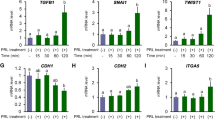Abstract
Purpose
To our knowledge, little is known about the effect of polarized and non-polarized uterine epithelial cells on cryopreserved embryo growth. This study was, therefore, set up to investigate the effect of these monolayers together with sequential culture media on vitrified-warmed mouse embryos in terms of blastocyst development, blastocyst quality, incidence of apoptosis and related genes expression.
Methods
Two cell vitrified-warmed mouse embryos were cultured in G-1™ver3 medium to the eight-cell stage when they were randomly assigned to three treatment groups of no co-culture (control), non-polarized and polarized mouse uterine epithelial monolayer co-culture. The culture medium was G-2™ver3 during the treatment phase. After 96 h on treatment, the significance of differences were evaluated by the one way analysis of variance for continuous data.
Results
In the polarized monolayer group, the hatched blastocyst formation and blastocyst quality improved significantly than other two groups (P < 0.05). Whereas the incidence of apoptosis and related gene expression such as Bax were higher in the blastocysts of control group (P < 0.05). The relative abundance of Bcl-2 mRNA to the β-tubulin was similar for all treatments.
Conclusion
Co-culture system involving polarized uterine epithelial cells and sequential culture media is a promising method for the improvement of vitrified-warmed mouse embryo development.


Similar content being viewed by others
References
Whittingham DG, Leibo SP, Mazur P. Survival of mouse embryos frozen to −196°C and −269°C. Science. 1972;178:411–4.
Balakier H, Cabaca O, Bouman D, Shewchuk AB, Laskin C, Squire JA. Spontaneous blastomere fusion after freezing and thawing of early human embryos leads to polyploidy and chromosomal mosaicism. Hum Reprod. 2000;15:2404–10.
James PS, Wolfe CA, Mackie A, Ladha S, Prentice A, Jones R. Lipid dynamics in the plasma membrane of fresh and cryopreserved human spermatozoa. Hum Reprod. 1999;14:1827–32.
Saunders KM, Parks JE. Effects of cryopreservation procedures on the cytology and fertilization rate of in vitro- matured bovine oocytes. Biol Reprod. 2000;61:178–87.
Stojkovic M, Machado SA, Stojkovic P, Zakhartchenko V, Hutzler P, Goncalves PB, et al. Mitochondrial distribution and adenosine triphosphate content of bovine oocytes before and after in vitro maturation: correlation with morphological criteria and developmental capacity after in vitro fertilization and culture. Biol Reprod. 2000;64:904–9.
Fuko E, Xia L, Downey BR. Ultrastructural changes in bovine oocytes cryopreserved by vitrification. Cryobiology. 1995;32:139–56.
Ahn HJ, Sohn IP, Kwon HC, Jo DH, Park YD, Min CK. Characteristics of the cell membrane fluidity, actin fibers, and mitochondrial dysfunctions of frozen-thawed two-cell mouse embryos. Mol Reprod Dev. 2002;61:466–76.
Chedid S, Van den Abbeel E, Van Steirteghem AC. Effects of cryopreservation on survival and development of interphase- and mitotic-stage 1-cell mouse embryos. Hum Reprod. 1992;7:1451–6.
Uechi H, Tsutsumi O, Morita Y, Takai Y, Taketani Y. Comparison of the effects of controlled-rate cryopreservation and vitrification on 2-cell mouse embryos and their subsequent development. Hum Reprod 1999;14:2827–32.
Betts DH, King WA. Genetic regulation of embryo death and senescence. Theriogenology. 2001;55:171–91.
Marquez-Alvarado YC, Galina CS, Castilla B, Leon H, Moreno-Mendoza N. Evidence of damage in cryopreserved and fresh bovine embryos using the TUNEL technique. Reprod Domest Anim. 2004;39:141–5.
Rajaei F, Karja NW, Agung B, Wongsrikeao P, Taniguchi M, Murakami M, et al. Analysis of DNA fragmentation of porcine embryos exposed to cryoprotectants. Reprod Domest Anim. 2005;40:429–32.
Rall WF, Fahy GM. Ice-free cryopreservation of mouse embryos at −196°C by vitrification. Nature. 1985;313:573–5.
Ali J, Shelton NJ. Design of vitrification solutions for the cryopreservation of embryos. J Reprod Fertil. 1993;99:471–7.
Kassai M. Cryopreservation of mammalian embryos. Mol Biotechnol. 1997;7:173–9.
Lane M, Schoolcraft WB, Gardner DK. Vitrification of mouse and human blastocysts using a novel cryoloop container-less technique. Fertil Steril. 1999;72:1073–8.
Lane M, Bavister BD, Lyons EA, Forest KT. Containerless vitrification of mammalian oocytes and embryos. Nat Biotechnol. 1999;17:1234–6.
Vajta G, Booth PJ, Holm P, Greve T, Callesen H. Successful vitrification of early stage bovine in vitro produced embryos with the Open Pulled Straw (OPS) method. CryoLetters. 1997;18:191–5.
Liebermann J, Tucker MJ. Effect of carrier system on the yield of human oocytes and embryos as assessed by survival and developmental potential after vitrification. Reproduction. 2002;124:483–9.
Kito S, Noguchi Y, Ohta Y, Ohhata T, Abe M, Shiomi N, et al. Evaluation of developmental competence of vitrified-warmed early cleavage stage embryos and their application for chimeric mouse production. Exp Anim. 2003;52:179–83.
Vajta G, Holm P, Greve T, Callesen H. Overall efficiency of in vitro embryo production and vitrification in cattle. Theroigenology. 1996;45:683–9.
Vajta G, Holm P, Greve T, Callesen H. Factors affecting survival rates of in vitro produced bovine embryos after vitrification and direct in-straw rehydration. Anim Reprod Sci. 1996;45:191–200.
Selman HA, El-Danasouri I. Pregnancies derived from vitrified human zygotes. Fertil Steril. 2002;77:422–3.
Massip A, Mermillod P, Wils C, Dessy F. Effects of dilution procedure and culture conditions after thawing on survival of frozen bovine blastocysts produced in vitro. J Reprod Fertil. 1993;97:65–9.
Kaidi S, Donnay I, Van Langendonckt A, Dessy F, Massip A. Comparison of two co-culture systems to assess the survival of in vitro produced bovine blastocysts after vitrification. Animal Reprod Sci. 1998;52:39–50.
Valojerdi MR, Movahedin M, Hosseini A. Improvement of development of vitrified two-cell mouse embryo by vero cell coculture. J Assist Reprod Genet. 2002;19:31–8.
Fong CY, Bongso A, Ng SC, Kumar J, Trounson A, Ratnam S. Blastocyst transfer after enzymatic treatment of the zona pellucida: improving in-vitro fertilization and understanding implantation. Hum Reprod. 1998;13:2926–32.
Fong CY, Bongso A. Comparison of human blastulation rates and total cell number in sequential culture media with and without co-culture. Hum Reprod. 1999;14:774–81.
Baghban Eslami Nejad MR, Valojerdi MR, Kazemi Ashtiani S. A comparison of polarized and non-polarized human endometrial monolayer culture systems of murine embryo development. J Exp Clin Assist Reprod. 2005;2:7.
Bowen JA, Newton GR, Weise DW, Bazer FW, Burghardt RC. Characterization of polarized porcine uterine epithelial model system. Biol Reprod. 1996;55:613–9.
Azadbakht M, Valojerdi MR, Mowla SJ. Development of mouse embryos co-cultured with polarized or non-polarized uterine epithelial cells using sequential culture media. Anim Reprod Sci. 2006;100:141–57.
Chen SU, Lien YR, Cheng YY, Chen HF, Ho HN, Yang YS. Vitrification of mouse oocytes using closed pulled straws (CPS) achieves a high survival and preserves good patterns of meiotic spindles, compared with conventional straws, open pulled straws (OPS) and grids. Hum Reprod. 2001;16:2350–6.
Vajta G, Holm P, Kuwayama M, Booth PJ, Jacobsen H, Greve T, et al. Open pulled straw (OPS) vitrification: A new way to reduce cryoinjuries of bovine oocytes and embryos. Mol Reprod Dev. 1998;51:53–8.
Cossarizza A, Kalashnikova G, Grassilli E, Chiappelli F, Salvioli S, Capri M, et al. Mitochondrial modification during rat thymocyte apoptosis: a study at the single cell level. Exp Cell Res. 1994;214:323–30.
Richter KS, Harris DC, Daneshmand ST, Shapiro BS. Quantitative grading of a human blastocyst: optimal inner cell mass size and shape. Fertil Steril. 2001;76:1157–67.
Thouas GA, Korfiatis NA, French AJ, Jones GM, Trounson AO. Simplified technique for differential staining of inner cell mass and trophectoderm cells of mouse and bovine blastocyst. Reprod Biomed Online. 2001;3:25–9.
Brison DR, Schultz RM. Increased incidence of apoptosis in transforming growth factor alpha-deficient mouse blastocysts. Biol Reprod. 1998;59:136–44.
Gilliland G, Perrin S, Bun HF. PCR protocols: a guide to methods and applications. New York: Academic; 1990.
Ashwood-Smith MJ, Morris GW, Fowler R, Appleton TC, Ashoren R. Physical factors are involved in the destruction of embryos and oocytes during freezing and thawing procedure. Hum Reprod. 1988;3:795–802.
Park SP, Kim EY, Oh JH, Nam HK, Lee KS, Park SY, et al. Ultra rapid freezing of human multipronuclear zygotes using electron microscope grids. Hum Reprod. 2000;15:1787–90.
Matsumoto H, Jiang JY, Tanaka T, Sasada H, Sato E. Vitrification of large quantities of immature bovine oocytes using nylon mesh. Cryobiology. 2001;42:139–44.
Leture-Konirsch H, Collin G, Sifer C, Devaux A, Kuttenn F, Madelenat P, et al. Safety of cryopreservation straws for human gametes and embryos: a study with human immunodeficiency virus-1 under cryopreservation conditions. Hum Reprod. 2003;18:140–4.
Ramezani M, Valojerdi MR, Parivar K. Effect of three vitrification methods on development of two-cell mouse embryos. Cryoletters. 2005;26:85–92.
Classen-Linke I, Kusche M, Knauthe R, Beier HM. Establishment of a human endometrial cell culture system and characterization of its polarized hormone responsive epithelial cells. Cell Tissue Res. 1997;287:171–85.
Wegner CC, Carson DD. Mouse uterine stromal cells secrete a 30-kilodalton protein in response to coculture with epithelial cells. Endocrinology. 1992;131:2565–72.
Xu JS, Cheung TM, Chan ST, Ho PC, Yeung WS. Temporal effect of human oviductal cell and its derived embryotrophic factors on mouse embryo development. Biol Reprod. 2001;65:1481–8.
Sawada H, Yamazaki K, Hoshi M. Trypsin-like hatching protease from mouse embryos: evidence for the presence in culture medium and its enzymatic properties. J Exp Zool. 1990;254:83–7.
Wyllie AH. The genetic regulation of apoptosis. Curr Opin Genet Dev. 1995;5:97–104.
Kamjoo M, Brison DR, Kimber SJ. Apoptosis in the preimplantation mouse embryo: effect of strain difference and in vitro culture. Mol Reprod Dev. 2002;61:67–77.
Jurisicova A, Latham KE, Casper RF, Varmuza SL. Expression and regulation of genes associated with cell death during murine preimplantation embryo development. Mol Reprod Dev. 1998;51:243–53.
Exley GE, Tang C, McElhinny AS, Warner CM. Expression of caspase and BCL-2 apoptotic family members in mouse preimplantation embryos. Biol Reprod. 1999;61:231–9.
Author information
Authors and Affiliations
Corresponding author
Additional information
Capsule Polarized uterine epithelial cell co-culture system can improve vitrified-warm mouse embryo development.
Rights and permissions
About this article
Cite this article
Azadbakht, M., Valojerdi, M.R. Development of vitrified-warmed mouse embryos co-cultured with polarized or non-polarized uterine epithelial cells using sequential culture media. J Assist Reprod Genet 25, 251–261 (2008). https://doi.org/10.1007/s10815-008-9231-4
Received:
Accepted:
Published:
Issue Date:
DOI: https://doi.org/10.1007/s10815-008-9231-4




